
This feature is included in our SEO Tools add-on! If you currently have only limited access but would like to take advantage of this helpful feature, you can update your membership options.
Introduction
While our Domain Overview tool can give you a quick snapshot of how well your website is doing in Google search results, our Backlink Analysis tool lets you dive even deeper.
Our Backlink Analysis tool provides you with valuable insights about your website’s backlinks and search engine visibility, to inform your off-site SEO efforts. Gain valuable insights about your backlinks over time and make informed decisions to enhance your website’s online presence and search engine visibility.
Whether you’re a seasoned SEO professional or a business owner wanting more visibility in search engines, this article will empower you to interpret metrics like Authority Score, navigate link attributes, and comprehend different backlink types.
Backlink Profile
Authority Score: The Authority Score is a proprietary metric from Semrush measuring your domain’s overall reputation and quality. It is based on three key factors: Link Power (quality and quantity of backlinks), Organic Traffic (estimated monthly average traffic), and Spam Factors (indicators of manipulation or spam in the link profile). A higher score suggests greater assumed weight for outbound links.
- Link Power: Reflects the quality and quantity of backlinks.
- Organic Traffic: Estimates the monthly average of website traffic.
- Spam Factors (Natural Profile): Identifies indicators of manipulation or spam in the link profile.
Note: Our customers with the best-performing websites usually have an Authority Score somewhere between the high teens and low twenties.
Total Backlinks: The total number of links pointing back to your site.
Referring Domains: The total number of domains, including common referring domains, linking to a given domain.
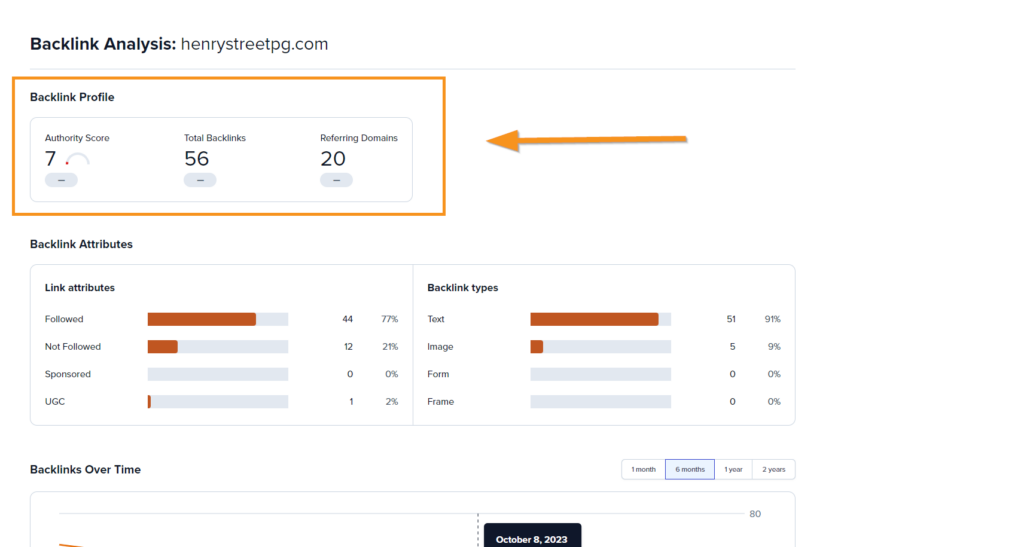
Backlink Attributes
Followed: Hyperlinks without additional attributes, indicating to search engines to pass trust and authority to the linked site.
Not Followed: Informs search engines not to pass authority.
UGC (User-Generated Content): Indicates links created by users or customers, allowing webmasters to specify non-editorial endorsement. Examples include links in forum posts and blog comments.
Backlink Types
- Text: Exists in the text content of the page.
- Image: Exists as a link when an image is clicked.
- Form: Exists as a link out from a form on the site.
- Frame: Hyperlinks embedded in HTML frames.
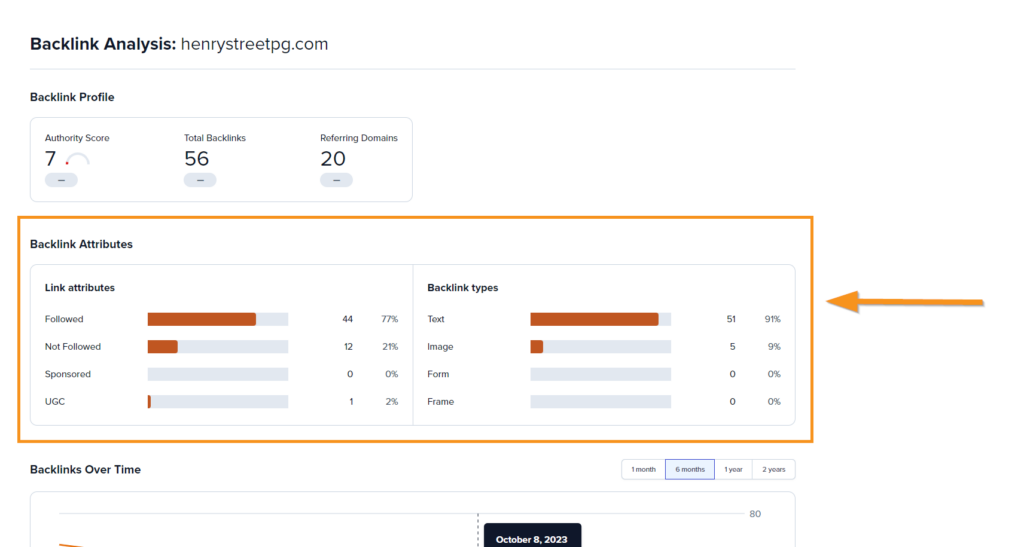
Backlinks Over Time
A line graph representing the quantity of backlinks on a site over specific time durations (1 month, 6 months, 1 year, or 2 years).
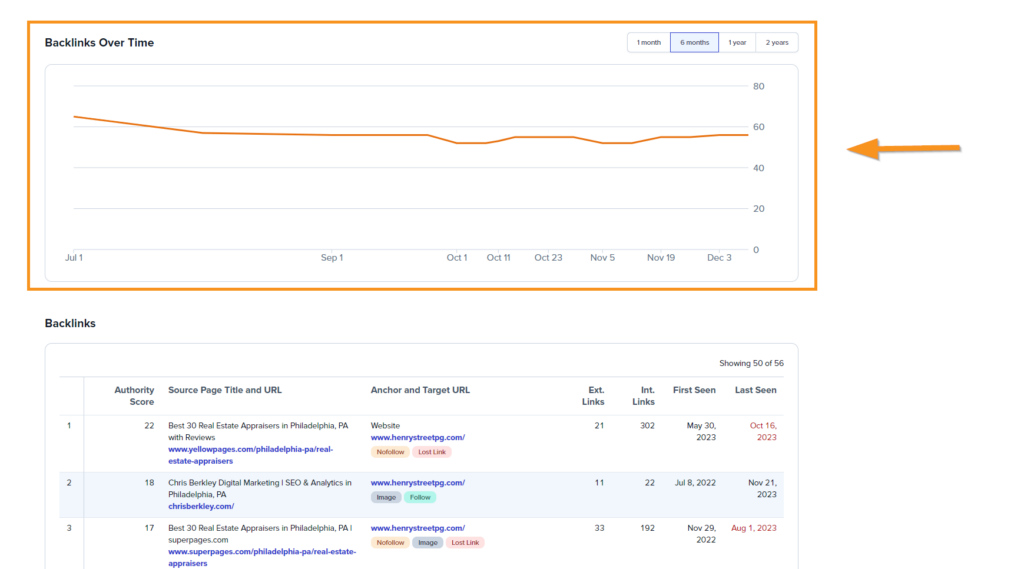
Backlinks
This section provides a detailed list with more information about each of your backlinks, sorted in order (highest to lowest) of the Authority Score of the links pointing back to your site:
Authority Score: Specifies the page’s authority score where the backlink exists.
Source Page Title and URL: Displays the title and URL of the page where the backlink exists.
Anchor and Target URL: Describes the text (Anchor) linking to your site and how your site is linked on the page (Target URL).
Badges: Examples include Image, Follow, Nofollow, and Lost Link.
- Follow: Standard hyperlinks passing trust and authority.
- Nofollow: Informs search engines not to pass authority.
- Image: Indicates the backlink exists within an image.
- Lost Link: Indicates the backlink has recently been removed or deleted.
- New Link: Indicates the backlink has recently been acquired.
- UGC: Indicates the backlink exists within user generated content such as a blog or social media.
- Sponsored (uncommon): Indicates the backlink exists within content that is marked as “sponsored” or “ad”.
- Form: Indicates the backlink exists as a link out from a form on the site.
- Frame: Indicates the backlink exists as a hyperlink embedded in an HTML frame.
Ext. (External) Links: The number of links linking out to other pages on the page where your backlink is located.
Note: If you notice an excessively high number of external links, it could be a sign of a questionable backlink. Consider disavowing it to maintain a healthy link profile.
Int. (Internal) Links: The number of links linking inward to other areas of the same site from the page where your backlink is located.
First Seen: Date that Semrush first saw the backlink.
Last Seen: Most recent date that Semrush saw the backlink.
Load more…: Allows loading another batch of 50 backlinks in your backlink profile. Press “Load more…” to continue.
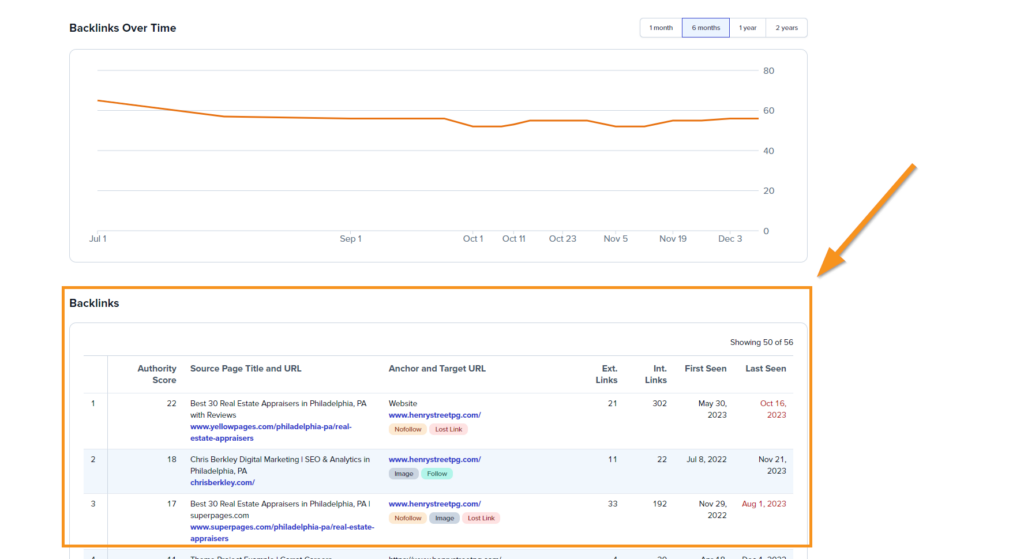
Backlink Analysis FAQs
What is a good Authority Score?
Generally speaking, the higher the Authority Score of a domain, the more trusted it is. It is based on a scale of 1 to 100, with higher numbers being better. That said, very few domains on the Internet will have extremely high scores in the 80s or 90s. (Think sites like Wikipedia or Facebook.)
When considering whether an Authority Score is good or bad, you should focus on the average Authority Score of websites in your industry.
For most Carrot customers, an Authority Score in the low double digits (high teens to 20s) is considered solid.
Does Google use my Authority Score to rank my site?
Not exactly. Authority Score is not a ranking factor.
While recent leaked Google documentation suggests that Google has their own way of measuring a sitewide authority score, it is different than the Authority Score provided here.
We use data from Semrush to power our Backlink Analysis tool, and the Authority Score you see for your site is based on Semrush’s proprietary metric to measure the health of your site’s domain. Using this Authority Score metric will provide valuable insights to guide you as you seek to improve your visibility in Google search, but it’s not a metric that is directly measured in the exact same way by Google.
How can I increase my Authority Score?
Authority Score helps measure the success of your off-page SEO efforts, which primarily consist of building citations and backlinks.
We recommend starting strong by building citations for your business.
After setting up citations, you’ll want to focus on building more relevant backlinks for your business. It’s important to focus on quality and relevance when building backlinks, rather than simply quantity.
Learn more:
Conclusion:
Understanding your backlink profile is key to optimizing your website’s performance in the digital landscape. By decoding metrics, understanding link attributes, and recognizing diverse backlink types, you’re equipped to strategically enhance your online presence.
As you navigate the dynamic world of backlinks over time, empowered with insights from this guide, you’re well-positioned to make informed decisions that drive sustained success and elevate your website’s standing in search engine rankings. Remember, a well-managed backlink profile is not just a metric—it’s a powerful tool in shaping your online success.
Learn More:
- Off-Page SEO & Building Backlinks
- How Many Backlinks Does it Take to Start Ranking Your Real Estate Website in Google?
- How to Use HARO to Get Backlinks
Close More Deals
with Carrot CRM
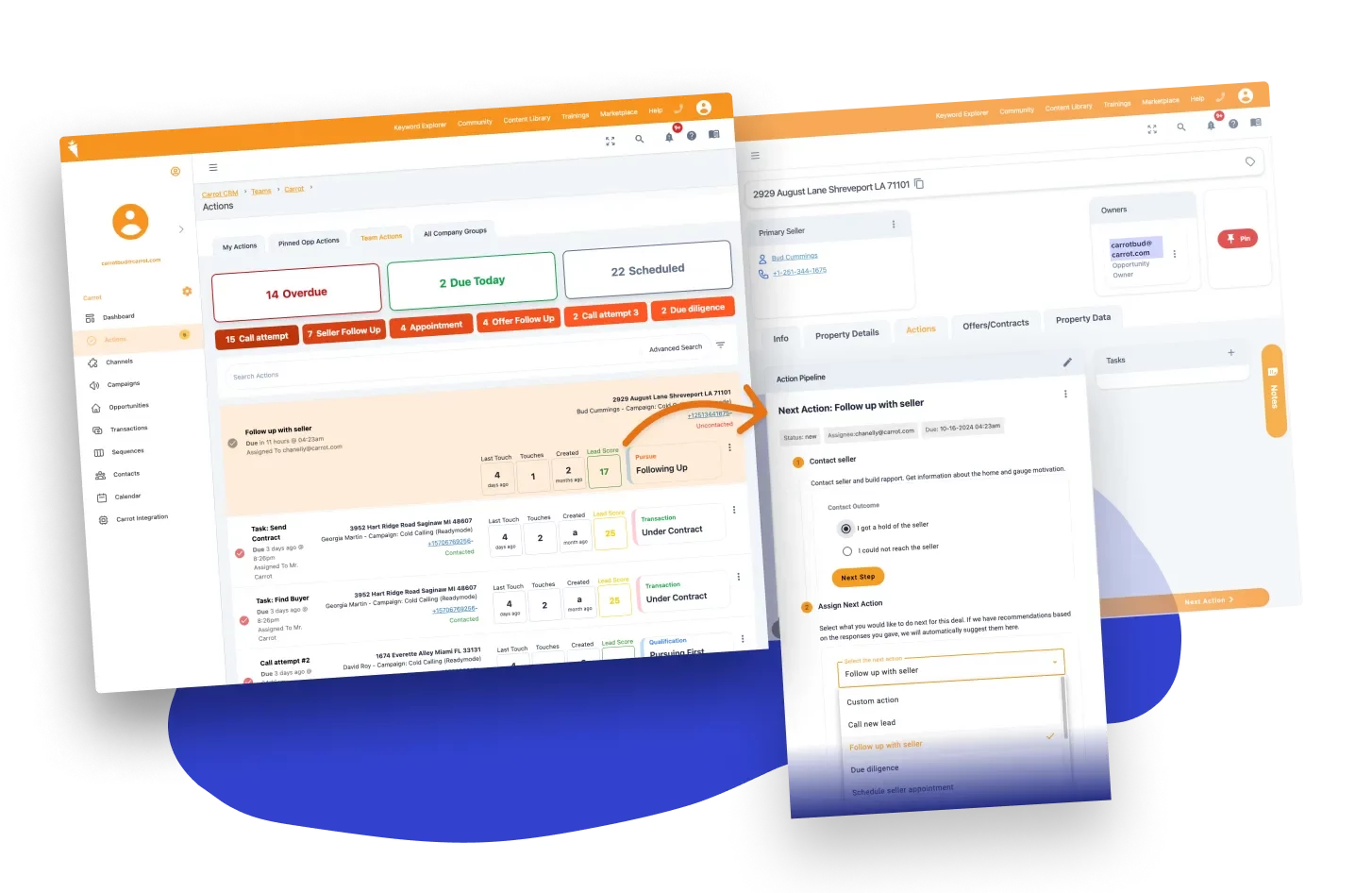
Grow your revenue and turn more leads into closed
deals with Carrot’s built-in CRM.
Premium Support
& 1:1 Strategy Calls

Members with our Premium Support Add-On can book
a 1:1 video calls for tech questions & strategic advice.

